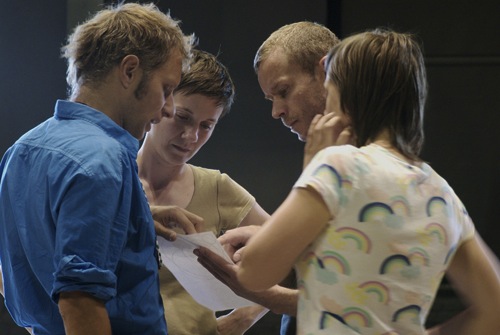Cows in Space
1998
Dance can talk to the body of the spectator directly. A part of the communication stream seems to flow through the eyes, without detour, into the stomach. Force, speed, lightness, tension, release, rotation, gravity and centrifugal force: such elements of the dance are connected to sensations which can be felt directly by the spectator. Some sports (for example sprinting, high jump, gymnastics and diving) or animals in motion can have a similar effect. As a choreographer I am interested in condensing this phenomenon in my compositions and in giving it meaning in a larger context. I am looking for possibilities to communicate directly with the body of the spectator by choreographic means. Those feelings work – having arrived through the body in the spectator’s conciousness – as illustrations to the parallely received signals on the mental level.
The most obvious way to include the phenomenon in choreography is to give the movement material of the dancers the particular quality that will create the effect. But an ingenious game with the in-between spaces can provoke a similar impact. The movements of the dancers in space result in movements of the in-between spaces. Speeds, positions in space and paths are factors that create tension fields in the space between the dancers, which can have an effect, that is as strong on the spectator as the movement of the dancers itself.
All choreographers, whose work I know, start their working process mostly by developing the dance material of the dancers. Decisions about placement in space and which pathways to follow form one of the last stages of a creation. The existing elements of material (some with inherent, but from each other and from a bigger structure independent pathways) are being organised in space and assembled to a total structure. The working method I am interested in aproaches the working process from exactly the opposite side.
I made a first try with this working method during my studies at the Rotterdam Dance Academy. For each of the five dancers I designed a floorpattern, each consisting of 3 intersecting geometric figures: an equilateral triangle, a square and a circle. Each form existed in 3 different sizes and each of the floorpatterns contained a large, a medium and a small shape. It was astonishing to see what a tension in the space between the dancers would arise, just by having them walk their circle paths simultaneously. It was as if the dancers were being moved by magnetic powers.
Another experiment in the same working direction I developed during a research period at Rosas Dance Company. A sequence from the film L’homme à la camera (Dziga Vertov, 1929, Russsia, experimental silent movie from the twenties) served as a score, which determined the pathways of the 13 dancers. The film sequence showed scenes of moving trams, cars and pedestrians, edited so ingeniously that the movement on the screen created a clearly perceivable rhythm. I tried to translate the rhythm and the dynamic as exactly as possible into the three dimensional space. The focus of a shot determined the size of the floor segment, which would be used for that same scene (general shot: whole stage, close up: small segment). The dancers moved within that part of the floor following the paths of the objects and people in the film, taking over tempi and directions as precisely as possible. Decisions about the placment of the different floor segments on the stage were arbitrary, and the trajects between them created an additional group movement. The whole movement sequence had a fascinatingly strange effect. A rigorous organisation was clearly present, the dancers knew obviously very well what made them move, for the spectator the logic stayed unfathomable and the succession surprising.
Thomas Hauert, Autumn 1997
Cows in Space received “Prix d’auteur” and “Prix Jan Fabre” at Rencontres chorégraphiques internationales de Seine-Saint-Denis in 1998
Concept & direction Thomas Hauert
Dance created & presented by Mark Lorimer, Sara Ludi, Mat Voorter, Samantha van Wissen, Thomas Hauert
Light & set design Simon Siegmann
Original musical score Bart Aga Sambal Oelek in collaboration with Alex Fostier
Pre-existing music John Adams
Costumes Patrick Pitschon
Production ZOO/Thomas Hauert
Coproduction Dans in Kortrijk (BE) / De Beweeging (BE) / Charleroi Danses (BE)
With the support of Ministerie van de Vlaamse Gemeenschap, administratie Cultuur, afdeling Muziek, Letteren, Podiumkunsten, Ein Kulturengagement des Lotteriefonds des Kantons Solothurn and Vlaamse Gemeenschapscommissie
Residencies Danswerkplaats (Kortrijk), Plateau (Brussel)
Thanks to Ida De Vos, Tanz in Olten, Ursula Berger, Cie. Pierre Droulers, Ruth Collier, Catherine Gouffau, Paul Ooghe, Samantha van Wissen, Alex Fostier, Anne Mousselet, Pascale Gigon, Aliocha Van der Avoort




